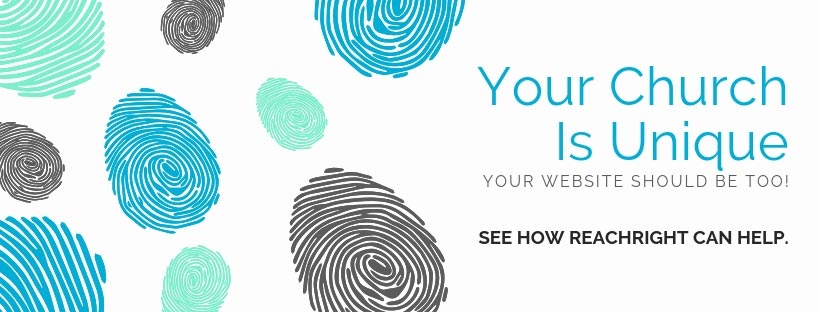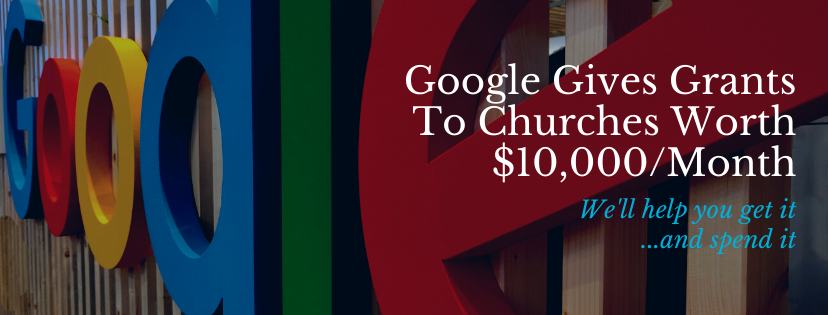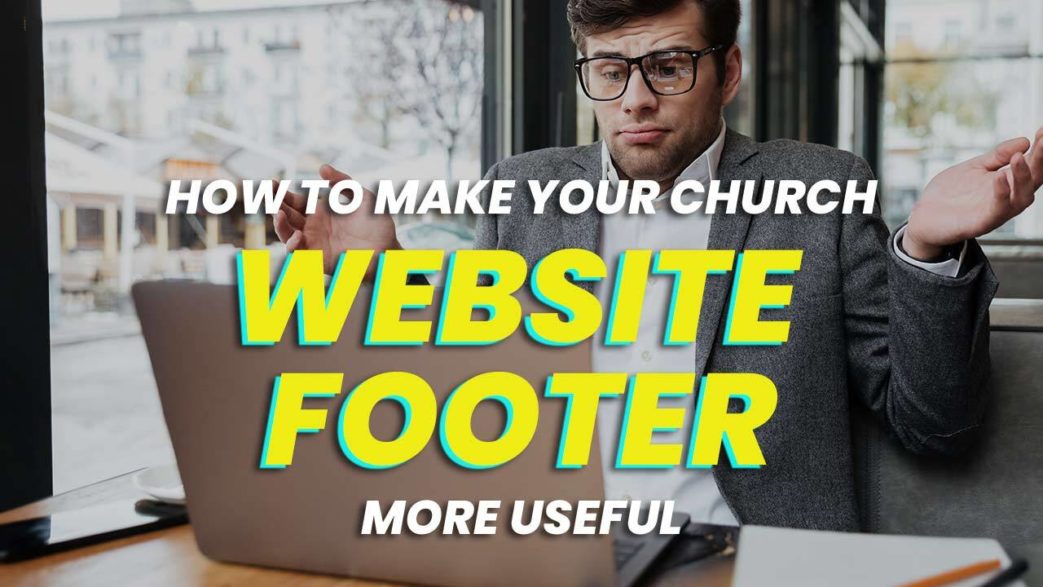What’s currently in your church website footer? For many sites, not just church sites, there’s very little there. But, it’s prime real estate to make life easier for visitors and keep people on your site.
While there are a wide variety of things you can include, you don’t have to try to stuff everything in the footer. The key is picking what you feel is most useful to your church website visitors.
All it takes is a few changes to the footer to increase traffic, boost the time people spend on your site and potentially increase your overall search rank.
Table of contents
- Add In All Operating Hours
- Include Address(es)
- Add All Your Church’s Social Media Profiles
- Include The Most Relevant Contact Details
- Consider Adding Widgets
- Create A Secondary Menu
- Add In A CTA
- Add A Quick About Us Section
- Include Another Search Option
- Ask Visitors To Subscribe
- Include A Link To Terms, Privacy Policy And Copyright Details
- Add A Contact Us Form
- Include Online Tithing
- Keep Everything Neatly Organized
- Add A “Back To The Top” Link
- More On Church Web Design

Add In All Operating Hours
There are several things your church website footer absolutely needs to contain. First, include all your operating hours. This includes service times and any other times your church is publicly open. You don’t need to include any special event times, such as a Christmas play.
However, you can link to your Events page to guide people to check out special things going on at your church. This is a great way to get visitors who were just looking for your hours to want to check out when else to visit your church.
The reason to include at least your hours is many people know that hours of operation are now listed neatly in website footers for easy access. Plus, no matter what page someone comes to first on your site, the hours are always listed at the bottom. This makes your site more user-friendly, which is always a bonus.
Include Address(es)
Unless your church is completely online-based, you should include your church’s address. Some website footers also include a small map showing nearby roads to help new visitors find the church easier. You can also turn your address into a link that goes to a page on your site that describes how to find your church.
For churches with multiple locations, things can get a little tricky. You don’t want to go overboard and add a dozen addresses to your footer. However, you should at least include a link to a page that lists all your locations and addresses. Since many multi-site churches have a main location, you may want to add that address and then link to additional locations.
Obviously, an address is a necessity for finding your church. This is one of the main things every church website footer needs. It’s also good for improving your local SEO.
Add All Your Church’s Social Media Profiles
You’ve likely seen websites with a row of social media icons in their footers. This is a super easy way to send website visitors to your social media profiles and also showcase which networks you use. Some websites, including church websites, also include a few of their latest posts, but that’s completely optional. However, you should include small social media icon buttons in your footer to increase social media engagement.
Include The Most Relevant Contact Details
So far, we’ve covered three things that are a must-have for your church website footer. There’s one last thing to make sure you include – contact details. This can be as simple as a phone number and/or email address. It doesn’t take up much space, but it does give visitors an easy to way to contact your church. If providing a phone number, you may want to add office hours beside it to let people know when they might be able to reach a live person versus voicemail.
As with multiple addresses and special events, you can also link to your contact directory on your website to help visitors contact the right area of your church, such as different ministry group pastors.
If you don’t add anything else on this list to your footer, make sure you add:
- Contact details
- Address
- Operating hours
- Social media buttons
As an optional addition, some churches offer live chat. You can include a link to this to help people get questions answered faster. Ensure you list the live chat hours so people know whether they’re interacting with a widget or if they’re able to chat with an actual person. Live chat’s actually becoming the preferred contact method, with 42% of people preferring it versus 23% for email.

Consider Adding Widgets
A fun, interactive element to add to your church website footer is a widget. Obviously, widgets can be almost anything. However, for churches, some options might include:
- List of latest blog posts
- List of latest sermons
- Social media posts (stick with one network to save space)
- Recently added church resources
Typically, only three or four items are listed at a time. Then, as you add new content to your site or social media pages, the lists are updated with the new content.
Create A Secondary Menu
An incredibly popular addition to website footers is a secondary menu. Some include links to all their pages, while others limit it to links to their main pages. For instance, your church might want to include a list of your most important pages, such as About, Home, Sermons, etc.
To make things more organized if you’re included more of an index is to separate page links by category. For mobile users, this is often a great way to quickly jump between pages without having to scroll all the way back to the top just to access your main menu.
Outside of easier navigation, this is also a great internal linking strategy. Internal linking is an ideal SEO strategy. Moz does a great job of getting into the more technical aspects and how to make this work better for your site.
Add In A CTA
Odds are, you already have a CTA (call-to-action) on your church website. It’s probably on multiple pages too, such as a prompt to sign up for your church newsletter. This might appear on your homepage, blog page and other pages too. It could even be a pop-up.
However, what if someone’s just glancing at the footer to get the essential details listed at the beginning of this post? They’ll miss that CTA. Or, what if they’re visiting a page that doesn’t have the CTA on it? By adding it to your footer as well, you’re ensuring it’s available on every single page.
It’s easy to add a newsletter signup box, freebie download button or any other CTA to your footer. Ideally, you should stick to one in the footer. Otherwise, things can get crowded quick. Plus, too many CTAs in one place tends to be more confusing than helpful. In this scenario, place your most important CTA in the footer. The others can be placed throughout your website.

Add A Quick About Us Section
Outside of service times and location, people want to know a few quick details about your church. For instance, how long has your church existed? What’s the denomination or is your church non-denominational? Are you more modern, traditional or a mix?
While your church should always have an About page to provide more of a history and other details, consider adding three or four short sentences about your church to your footer. Think of this as the Cliff’s Notes version of your About page. It’s a simple introduction that makes visitors want to know more. Add a “more” link at the end of the brief summary to send people directly to your About page.
Include Another Search Option
Easy navigation is crucial for making your church website more user-friendly. While you should always avoid certain navigation mistakes, like adding too many items or putting your menu in a weird place, one thing is always useful – a search box. Often, this is only added to your blog page, but it can be a part of every page of your site, including on the footer.
If someone’s searching for something on your website and scrolls to the end of a page, what would make them happier than seeing a convenient search box in the footer? All you need is a small search box and a button. It doesn’t take up much space and is incredibly helpful for finding more info on your church’s site.
Ask Visitors To Subscribe
Since getting visitors’ contact details is so important, include a way for visitors to subscribe to your church newsletter. This works well as your CTA. Not only are you providing an easy way for visitors to stay in contact with your church, but you’re ensuring you’re able to stay in contact with them.
As an alternative to the traditional subscribe CTA, you can also ask people to follow your church on social media. Include this CTA near your social media icons. Either way, this is encouraging people to subscribe to the latest updates about your church.
Make sure you follow up quickly with any new subscribers if subscribing by email. Some churches even include a weekly thank-you on their social media pages mentioning their new followers. Obviously, this works better for smaller churches and helps show your church is truly appreciative of new followers.
For email, send out your latest church newsletter along with a thank you for subscribing not. Crafting a great newsletter also helps you keep subscribers, both members in your church and your online followers.
Include A Link To Terms, Privacy Policy And Copyright Details
While not absolutely necessary, it’s a good idea to have a link to any Terms of Service, Privacy Policy and/or Copyright pages. If your church doesn’t have any user logins or other areas to provide personal details and you’re not accepting money on your site, you probably don’t need a ToS or privacy policy. However, if you are accepting money and personal details, include both protect your church legally.
However, you should always include copyright details. This prevents others from stealing your website and website content. It might not seem like a major deal, but if a scammer steals your church website and spoofs it to infect visitors with malware, it reflects badly on your church, even though you’re completely innocent. Having a copyright in place gives you legal ownership and helps you take action if anyone does try to do something wrong.

Add A Contact Us Form
Often, either an alternative or addition to contact details, a church website footer contains a simple contact form. This includes a place for the visitor’s email address and a quick message. While you should still have a Contact Us page with all relevant details on how to contact your church, having a short form in your footer gives visitors a way to contact you no matter what page they’re on.
Obviously, if your footer doesn’t have space, this is completely optional. Just make sure you have contact details in place so visitors still have an easy way to contact you.
Include Online Tithing
When it comes to adding online tithing to your church website footer, this can be in addition to your main CTA or be the only CTA. A drop down box with a few suggested amounts and an option for a custom amount then leads directly to your online tithing platform. Or, if you don’t want to add a drop-down box, simply add a link called “Online Giving,” “Online Tithing,” “Give Today” or anything similar.
A link is a great option if you already have a CTA in place. This reduces clutter, but still helps encourage people to give if they can.
Keep Everything Neatly Organized
There’s one rule to a great church website footer – keep it neat and organized. Trying to shove in everything on this list creates a chaotic footer. Imagine if you tried to put your entire church website on a single page. It’d be a mess and no one would be able to find anything.
Include the four most important elements and then pick several others to add. You want your footer to be informative and give your visitors access to what they need most.
Mockplus has a list of 20 website footers to help inspire you. While they’re not from churches, they do give you an idea of what’s possible in the underused footer area.
Add A “Back To The Top” Link
Finally, you might want to include a “back to the top” link or button. This is especially helpful on mobile devices. It reduces the need to scroll back. It’s a simple thing, but makes your church website even easier to use.
Ready to transform your church website and add an incredible footer? See how our free website strategy review can help you figure out what users want most from your site to create better sites and footers.





Comments 2
Thank you
You are welcome. Hope you learn a thing or two from this blog post.